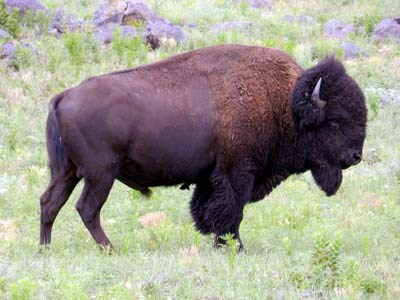Last updated: November 6, 2017
Article
Bison Bellows: The Ungulate Conundrum

Photo courtesy of Corinna Bontly
The term ungulate means "being hoofed" or "hoofed mammal." Zebras, giraffes, pigs, gazelles, and bison are all ungulates. Ungulates have an adaptive behavioral strategy to be continually on the move in order to avoid resource scarcities and reduce the risk of predation. With this fundamental instinct and natural urge for ungulates to move continually, managers and biologists face a growing challenge with respect to management and conservation of these species. It seems that ocean fish and birds are the only species that can travel on their own accord. Therefore, in terms of ungulate and bison management, the focus certainly centers on the question of how to conserve species if their natural movements are restricted and impeded in today's human-dominated landscape.
Biologists suggest that survival for many wildlife populations, including bison, depends on their ability to move across unfragmented landscapes. However, these unobstructed landscapes are diminishing due to increasing barriers that restrict natural movement, such as housing developments, roads, and fences. The loss of migration routes and ability to move freely across the landscape are not only affecting bison, but also other ungulate species that migrate across different ecosystems. Habitat fragmentation not only decreases wildlife's ability to move throughout the landscape, but can also have detrimental effects on the survival, genetics, behavior, and reproduction of the species. For example, restricted movement can increase the potential for inbreeding---the mating of closely related individuals---because individuals cannot find new mates. Inbreeding can also increase the potential for deleterious mutations to be passed on from generation to generation.
Restricting the movement of bison can certainly have harmful consequences, so why have we limited bison movement and how can managers overcome this fundamental challenge? Answering these two questions is very difficult to solve. Bison conservation is more than a numbers game. In other words, simply increasing the number of individuals in a herd does not mean bison populations are restored. There are numerous factors that influence proper management and allowing for natural movement is one of these aspects. Indeed, management must assess the intensity of control and the possibility of allowing bison to roam freely.
Ultimately, bison conservation is in a predicament. The fundamental ecology of bison tells bison they should move. On the other hand, anthropogenic factors, such as increased development, prevent bison from doing this. Because human activities disrupt natural behaviors and distributions, managers often remove individuals through culling or translocation methods. There are also policies, conflicts of interest, stakeholder power differences, public perceptions, and many other factors that affect bison movement. Bison conservation must have integrative approaches that incorporate ecology, biology, stakeholder engagement, problem solving, and shared learning. In the end, the confinement and increasing domestication of bison may have long-term consequences affecting their behavior and activity patterns.
